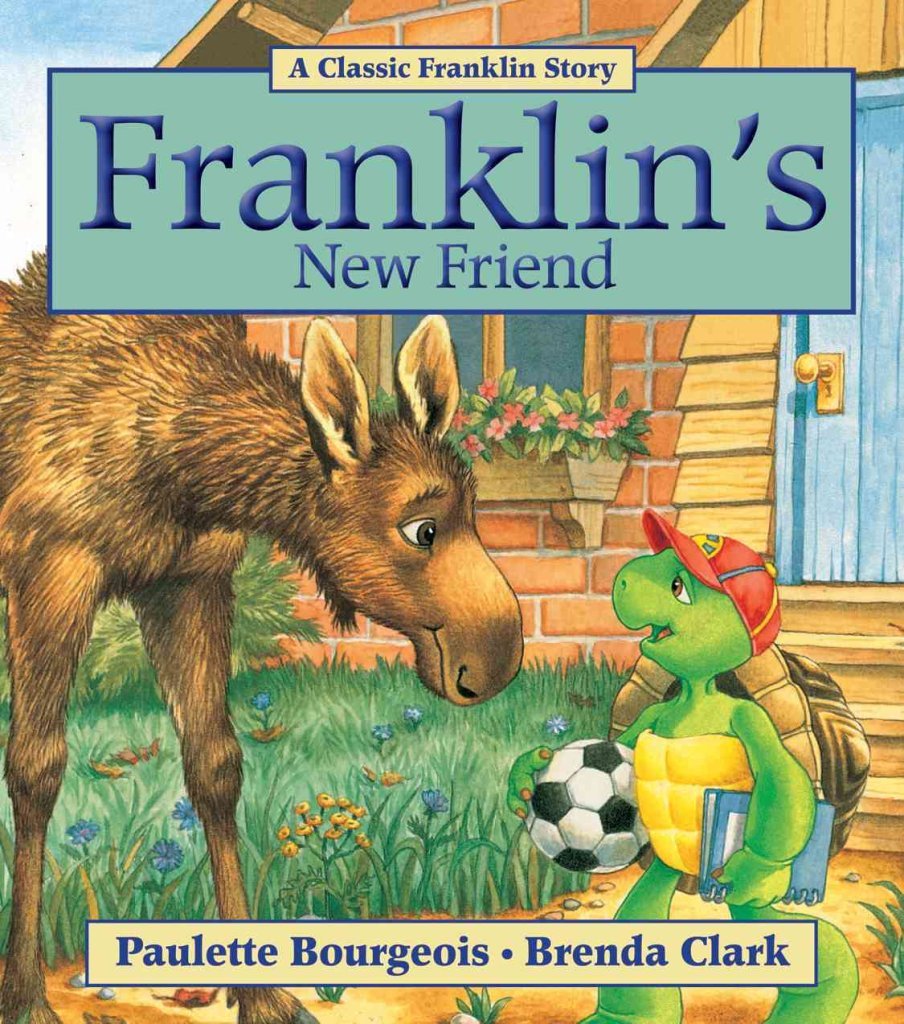This month's Book Nook topic is...
Relating to your child’s experiences with Franklin’s New Friend

To truly understand stories, children must go beyond the words and pictures on the page and figure things out that are not specifically stated in the book. In other words, they must “read between the lines” to understand why things happen.
One effective technique for helping your child read between the lines is to relate what’s happening in the book to your child’s existing knowledge and experiences. When your child thinks about a similar situation that he or she was in, or thinks about information he already knows on a topic, he can better understand the events in the story and how they relate to the characters’ feelings and motivations. These ideas are often not stated explicitly in the book but are crucial for understanding the story.
The Book:
Franklin’s New Friend, by Paulette Bourgeois
Why we picked it
In this book, a new family of moose moves into Franklin’s town. Franklin is a little afraid because he’s never known a moose before – and they’re really big! When one moose shows up at school the next day, Franklin and his friends decide he’s not very friendly and Franklin tries to avoid him. But Franklin soon realizes that he and Moose have a lot in common and that they really can be friends.
This is a great book for relating to your child’s knowledge and experiences because it deals with some themes that many children will be familiar with – being new somewhere and afraid you might not fit in, and also being unsure about someone who seems different.
How to relate to your child’s knowledge and experiences
You can relate the story to your child’s experiences in two main ways:
1. Make comments
Make comments that link the story to your child’s life. Unlike questions, comments don’t require a response, but if you make a comment that relates to something your child has experienced, and wait, chances are your child will want to add her own thoughts!
In Franklin’s New Friend, the author never explicitly states why Moose is very quiet at first and why he says “no” when Franklin asks if he wants to play. Help your child understand why Moose might be acting this way by reminding her of a time when she was new somewhere. For example, “Remember your first day at summer camp? You were a little sad and worried because you didn’t know anyone, so you mostly kept to yourself that day. It can be scary when you’re new somewhere and no one knows you. You might be afraid no one will like you and that you won’t make friends.”
You can also help your child understand Franklin’s emotions by saying something like, “This reminds me of when our neighbours moved in and you weren’t sure about being Sara’s friend because she spoke a different language and wore different clothes. Sometimes when someone seems really different from us, we think we can’t have much in common and we can’t be friends. But look what happened with you and Sara – once you started to play with her and got to know her a little better, it turned out you liked to do a lot of the same things and now you’re friends!”
After you make a comment linking the story to your child’s life, wait and see what she has to say. Follow her lead by responding to what she says, and you’ll find there are many ways to relate the book to her experiences and knowledge.
Comments like these, and the conversations that come from them, make the meaning of the story much clearer for your child because she now has a concrete example from her own life.
2. Ask questions
By the second or third reading, your child has a basic understanding of the storyline, so you can pause to ask questions that deepen understanding.
When you see that your child is interested in a particular part of the story, ask a question that links what’s happening at that moment with something your child has experienced. Here are some examples:
- If your child points or comments on Moose’s sad face, you could ask something like, “Did you ever have a time when you felt sad or scared because you didn’t know anyone around you?”
- If you notice your child paying close attention when Franklin runs away from Moose to join his friends outside, you could say, “Were you ever brand new somewhere and felt like everyone else was ignoring you? How did that make you feel?”
- If your child smiles or comments when Franklin and Moose make the Bake Sale sign together, you could say, “How do think Moose feels now that Franklin is talking to him and they’re doing things together?”
Questions like these allow your child to draw connections between herself and the story, which really strengthens her understanding.
Happy reading!
More Resources
The strategies in this Book Nook post are drawn from Hanen’s practical, research-based guidebooks for building emergent literacy. Explore the links below to learn more about how these guidebooks can support you.
For Parents I'm Ready! guidebook
I'm Ready! guidebook
For Educators ABC and Beyond guidebook
ABC and Beyond guidebook
